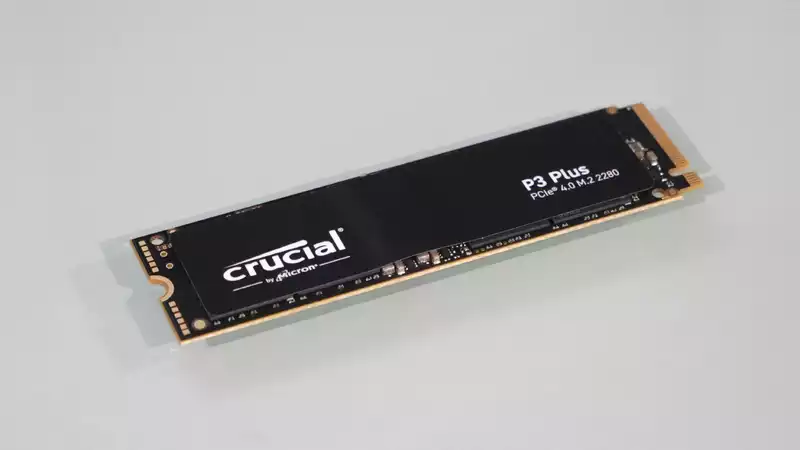High capacity for little money. That is the problem with the new Crucial P3 Plus M.2 SSD we tested in a 2TB configuration. This SSD uses QLC flash memory to provide increased storage capacity at a noticeably lower cost, and at the time of this review, this 2TB drive was about $179 (£205). But is there a different price to pay here?
The short answer is yes: the Crucial P3 Plus uses parent company Micron's latest 176-layer QLC NAND chip, where QLC stands for quad-level cells, indicating four bits of storage per memory cell. This is one more than the TLC or triple-level cell flash memory typically used in premium high-performance SSDs.
Now, it is well known that as cell-level bit density increases, both performance and endurance take a hit. However, it is worth remembering the reasons for this in broad strokes. Simply put, the complexity of reading and writing to a QLC cell is twice that of a TLC cell. That means it takes longer. Much longer. This is the hit to performance.
As for durability, it comes down to the fact that every time a write is made to a cell, the oxide film required to store the charge representing the bits (0s and 1s) that make up the actual data wears slightly. More bits per cell means more frequent writes to each cell and therefore more rapid wear. I hope you keep all of these ideas in mind.
Available in 500GB, 1TB, 2TB, and 4TB capacities, it is not just the choice of flash chips that makes the new Crucial P3 Plus a value-oriented product. In contrast to Crucial's more expensive SSDs, which use in-house controller chips, the P3 Plus is powered by the Phison PS5021-E21T.
The Phison E21T is essentially a cheap PCIe 4.0 controller, offering only four memory channels compared to eight in competing products. It is also a so-called DRAM-less chip, meaning it does not support dedicated DDR cache memory. Instead, system memory serves as the primary cache.
Speaking of cache, one of the most important elements of a QLC drive is SLC cache provisioning, or the percentage of the drive that is allocated to operate in faster SLC mode. In this case, it is about 20% of the drive's available free space. As the drive fills up, the amount of available SLC cache decreases. The important point, however, is that QLC technology tends to make sense for large drives where SLC provisioning can be quite generous. These drives are large enough to be half the capacity, allowing for several hundred GB of high-performance SLC cache.
In any case, according to Micron, the latest 176-layer QLC chips are about 25% faster than traditional 128-layer QLC memory. This 2TB model reads at 5,000MB/s and writes at 4,200MB/s, clearly lagging behind typical TLC-based drives; Crucial does not bother to cite IOPS figures. Still, the P3 Plus comes with Crucial's usual 5-year warranty and 44TB rated write endurance.
Symbolic of the impact of QLC memory, the latter figure is barely a third above the endurance offered by premium TLC-powered 2TB drives like the WD Black SN850 (opens in new tab). Of course, it is the absolute values that matter, not the comparisons: is 440TB enough? "This would mean using 240GB daily for five years. That's plenty of capacity for all but the most demanding users.
If the P3 Plus is going to last long enough, how about performance in the meantime: the peak synthetic throughput measured by ATTO and others is 6,890 MB/s read and 5,940 MB/s write, which is acceptable enough. But other numbers are rather erratic: CrystalDiskMark shows more realistic numbers, with the premium drive clocking in at over 7GB/s, while the drive achieves read speeds of less than 5GB/s. 263MB/s on the P3 Plus, 4K. write is actually quite good, the 63 MB/sec 4K read not so much.
PCMark 10 storage, perhaps a more realistic assessment, likewise returns a rather large shortfall against TLC-based drives. Falling below 2,500 points where top tier drives can score 3,500 points, as well as 68ms for latency in the mid-40s compared to performance drives, is a clear result of low-cost, high-capacity QLC memory and low-cost controller chips.
There is more good news regarding sustained performance: the P3 Plus showed no signs of thermal throttling and maintained peak performance during the pre-test fill routine until the SLC cache was completely exhausted after 500GB of writes, with a maximum temperature of 56°C. Nevertheless, once the SLC cache was fully exhausted, performance fell off a cliff completely, with write speeds dropping to a mere 90 MB/sec.
Overall, the Crucial P3 Plus performs as one would expect from a high-capacity QLC drive, and while it does not exhaust the SLC cache, it is certainly fast enough for most needs. There are also no concerns about long-term durability.
The main question is what happens when the SLC cache runs out. The whole point of such a large, inexpensive drive is undoubtedly to fill it up with large amounts of data. At that point, the fundamental performance of QLC memory is exposed, and in some scenarios, you will face performance problems. In that sense, it is worth noting that for only $30 more, you can buy Crucial's P5 Plus (open in new tab) TLC drive. After all, we would be spending our money there. The savings from this QLC drive alone are not enough to justify the cost.
.

Comments